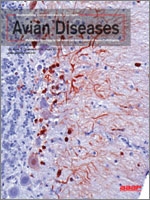In January 2015, a highly pathogenic Eurasian lineage H5N8 avian influenza (AI) virus (AIV) was detected in a commercial meat turkey flock in Stanislaus County, CA. Approximately 3 wk later, a similar case was diagnosed in commercial brown layers from a different company located in Kings County, CA. Five 14-wk-old turkey hens were submitted to the California Animal Health and Food Safety Laboratory System (CAHFS), Turlock, and eleven 12-wk-old chickens were submitted to CAHFS, Tulare laboratory due to an acute increase in flock mortality. Gross lesions included enlarged and mottled pale spleens and pancreas in turkeys and chickens. Histologically, the major lesions observed in turkeys and chickens were splenitis, pancreatitis, encephalitis, and pneumonia. In both cases, diagnosis was based on real-time reverse transcriptase PCR (RRT-PCR), sequencing, and virus isolation from oropharyngeal and cloacal swabs. Confirmatory diagnosis and AIV characterization was done at the National Veterinary Services Laboratory, Ames, IA. The sequence of the AIV from both cases was 99% identical to an H5N8 AI virus (A/gyrfalcon/Washington/41088-6/2014) isolated from a captive gyrfalcon (Falco rusticolus) from Washington State in December 2014. Immunohistochemistry (IHC) performed on various tissues from both cases indicated a widespread AIV tissue distribution. Except for minor variations, the tissue distribution of the AI antigen was similar in the chickens and turkeys. There was positive IHC staining in the brain, spleen, pancreas, larynx, trachea, and lungs in both chickens and turkeys. Hearts, ovaries, and air sacs from the turkeys were also positive for the AI antigen. The liver sections from the chickens had occasional AI-positive staining in mononuclear cells, but the IHC on liver sections from the turkeys were negative. The bursa of Fabricius, small intestine, kidney, and skeletal muscle sections were negative for the AI antigen in both chickens and turkeys.
How to translate text using browser tools
15 April 2016
Highly Pathogenic Eurasian H5N8 Avian Influenza Outbreaks in Two Commercial Poultry Flocks in California
Simone Stoute,
Richard Chin,
Beate Crossley,
C. Gabriel Sentíes-Cué,
Arthur Bickford,
Mary Pantin-Jackwood,
Richard Breitmeyer,
Annette Jones,
Silvia Carnaccini,
H. L. Shivaprasad
ACCESS THE FULL ARTICLE

Avian Diseases
Vol. 60 • No. 3
September 2016
Vol. 60 • No. 3
September 2016
avian influenza
California
chickens
commercial
highly pathogenic
turkeys




